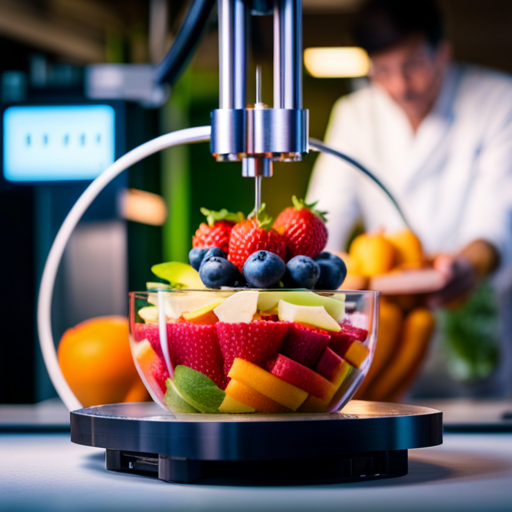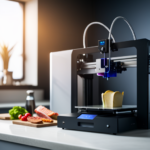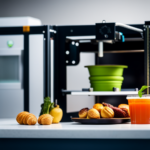In the age of technological innovation, the culinary world is witnessing a paradigm shift through the integration of 3D food printing. This article explores the cutting-edge advancements in nutrition and health by harnessing the potential of 3D food printing to create customized, nutrient-rich food.
By examining the impact on dietary restrictions, sustainability, and the future implications for nourishment, this article aims to shed light on the transformative potential of 3D food printing in enhancing nutritional value.
The Basics of 3D Food Printing
The process of 3D food printing involves the use of specialized printers to create edible items layer by layer, offering precise control over the composition and structure of the food products. This printing process begins with the preparation of food ingredients that are turned into a paste or liquid form suitable for extrusion through the printer’s nozzle. The printer then deposits these materials in precise shapes and patterns, gradually building up the final 3D food product.
When it comes to food safety, 3D food printing presents unique challenges. Ensuring that the printed food is safe for consumption requires attention to several factors. These include the sourcing and handling of ingredients, the maintenance and cleanliness of the printing equipment, and the prevention of contamination during the printing process. Additionally, the printing materials must meet food-grade standards to guarantee that the final product is safe for consumption.
Researchers and industry experts continue to explore and develop best practices for maintaining food safety throughout the 3D printing process, aiming to establish clear guidelines and standards for the industry.
Customized Nutrient-Rich Food Creations
Utilizing advanced 3D food printing technology, one can now create customized nutrient-rich food creations with precise control over the composition and nutritional content. This innovative technology allows for the development of personalized diets tailored to individual nutritional needs.
By incorporating specific nutrients, such as vitamins, minerals, and proteins, into the 3D printing process, it becomes possible to produce food items that address specific dietary requirements. For instance, individuals with particular dietary restrictions, such as those related to allergies or chronic conditions, can benefit from the ability to customize their food based on their unique nutritional needs.
Moreover, this approach facilitates the creation of nutrient-dense meals that can contribute to overall health and well-being. The potential to personalize the nutritional content of food through 3D printing represents a significant advancement in the realm of food technology, offering a promising solution for addressing individual dietary needs and preferences.
As this technology continues to evolve, it holds the potential to revolutionize the way we approach nutrition and dietary planning.
Advantages of Enhanced Nutritional Content
Enhanced nutritional content in 3D printed food offers precise control over essential nutrients, catering to individual dietary needs and promoting overall health. This innovation in food technology allows for the customization of nutrient enrichment in food, resulting in numerous health benefits. By precisely controlling the composition of nutrients such as proteins, vitamins, and minerals, 3D food printing enables the creation of functional foods tailored to address specific nutritional deficiencies or health conditions. This level of personalization is unprecedented in traditional food manufacturing processes and has the potential to revolutionize the way we approach nutrition and health.
Furthermore, the ability to enhance the nutritional content of food through 3D printing can contribute to addressing prevalent health issues such as malnutrition and diet-related diseases. With this technology, it becomes possible to fortify foods with essential nutrients, thereby offering a convenient and effective means of improving public health.
As we explore the advantages of enhanced nutritional content in 3D printed food, it’s imperative to consider the sustainable and healthy ingredients that form the basis of this innovative approach to food production.
Sustainable and Healthy Ingredients for 3D Printing
Sustainable and healthy ingredients for 3D printing play a crucial role in ensuring the nutritional quality and environmental impact of printed food.
Nutrient-rich printing materials offer the potential to enhance the nutritional value of 3D printed food, providing a means to incorporate essential vitamins, minerals, and other bioactive compounds.
Additionally, considering the environmental impact of ingredients is essential for promoting sustainability in 3D food printing, as it can reduce waste and resource consumption.
Nutrient-Rich Printing Materials
Nutrient-rich printing materials are essential for maintaining the health and sustainability of 3D food printing.
Edible ink and innovative recipes play a crucial role in ensuring that the printed food items are not only visually appealing but also nutritionally dense.
Edible ink, formulated from natural ingredients such as fruit and vegetable extracts, provides a safe and healthy coloring option for 3D printed foods without compromising their nutritional value.
Additionally, innovative recipes incorporating sustainable and nutrient-rich ingredients, such as algae, insects, and plant-based proteins, are being developed to create printing materials that are rich in essential nutrients like protein, fiber, vitamins, and minerals.
The use of these sustainable and healthy ingredients not only enhances the nutritional value of 3D printed food but also contributes to the overall sustainability of the food printing process.
Environmental Impact of Ingredients
The utilization of environmentally sustainable and healthy ingredients for 3D food printing is pivotal in ensuring the nutritional density and ecological responsibility of the printed food items. Environmental sustainability and responsible ingredient sourcing are essential considerations in the 3D food printing process. By selecting ingredients that are sourced sustainably and are nutritionally dense, the environmental impact of 3D food printing can be minimized while enhancing the overall nutritional value of the printed food items. Key factors to consider when choosing ingredients for 3D food printing include their carbon footprint, water usage, and overall ecological impact. Below is a table illustrating examples of environmentally sustainable and healthy ingredients for 3D food printing:
| Ingredient | Environmental Sustainability | Nutritional Density |
|---|---|---|
| Algae | High | Excellent |
| Insect Proteins | Very High | High |
| Plant-based | High | Varied |
This careful selection of ingredients not only impacts the nutritional value but also contributes to sustainable and environmentally responsible food production methods. This responsible approach to ingredient selection aligns with the growing emphasis on sustainable practices within the food industry. As the impact of ingredient sourcing on the overall sustainability of 3D food printing becomes increasingly apparent, the focus shifts to understanding its impact on dietary restrictions and special diets.
Impact on Dietary Restrictions and Special Diets
One potential benefit of 3D food printing technology is its ability to accommodate various dietary restrictions and special diets, providing a promising solution for individuals with specific nutritional needs. For individuals with food allergies or intolerances, 3D food printing allows for the creation of allergen-free options by using alternative ingredients and customized recipes. This can be particularly beneficial for individuals with celiac disease, lactose intolerance, or other food sensitivities.
Additionally, 3D food printing enables the creation of personalized meal plans tailored to individual dietary requirements. By precisely controlling the composition of the printed food, including the amount of nutrients such as proteins, carbohydrates, and fats, it becomes possible to address specific dietary needs, such as those of athletes, individuals with metabolic disorders, or those following specialized diets like the ketogenic diet.
The ability of 3D food printing to cater to dietary restrictions and special diets highlights its potential to revolutionize the way we approach food production and consumption, with significant implications for nutrition and health.
Future Implications for Nutrition and Health
A critical consideration of the future implications for nutrition and health in relation to 3D food printing technology reveals the potential for significant advancements in personalized dietary solutions and improved nutritional outcomes.
-
Customized Nutrition: 3D food printing offers the possibility of tailoring food products to individual nutritional needs, allowing for precise control of ingredients and nutrients to meet specific dietary requirements.
-
Enhanced Nutrient Absorption: The utilization of 3D printing to create foods with optimized textures and structures can improve digestibility and nutrient absorption, potentially benefiting individuals with malabsorption issues or specific nutrient deficiencies.
-
Health-focused Ingredients: Future applications of 3D food printing may involve incorporating functional ingredients, such as probiotics, prebiotics, and nutraceuticals, into printed foods to promote gut health and overall well-being.
-
Chronic Disease Management: The technology’s capacity to produce specialized, nutrient-dense foods could support the management of chronic conditions like diabetes, cardiovascular diseases, and obesity by offering tailored dietary options that align with health recommendations.
These potential future applications of 3D food printing hold promise for advancing personalized nutrition and improving health outcomes.
Frequently Asked Questions
Can 3D Food Printing Be Used to Create Personalized Meal Plans Based on Individual Dietary Needs and Preferences?
Personalized nutrition is an emerging field aiming to tailor dietary plans to individual needs. Customized meal plans, based on dietary requirements and preferences, can be formulated using 3D food printing technology, offering a potential avenue for precise and personalized nutrition.
How Does 3D Food Printing Affect the Taste and Texture of the Food Compared to Traditional Cooking Methods?
Taste perception and texture analysis of foods produced through 3D printing compared to traditional cooking methods have been a subject of interest. Research indicates that 3D printed foods can offer unique textures and flavors, enhancing culinary experiences.
Are There Any Safety Concerns or Potential Health Risks Associated With Consuming 3D Printed Food?
Safety concerns and potential health risks associated with consuming 3D printed food stem from the use of food-grade materials, cross-contamination, and regulatory oversight. Understanding and addressing these factors are crucial in ensuring the safety of 3D food printing technology and its consumption.
Can 3D Food Printing Technology Be Used to Address Food Insecurity and Malnutrition on a Global Scale?
Food accessibility and technological innovation have the potential to address global food insecurity and malnutrition. 3D food printing technology offers a promising avenue for creating nutritious, customized food products that could contribute to alleviating these challenges.
What Are the Potential Ethical Considerations and Implications of 3D Printing Food, Particularly in Relation to Food Production and Distribution?
Ethical considerations surrounding 3D food printing encompass equitable food distribution and minimizing environmental impact. Addressing these concerns is crucial, as it involves key aspects like food waste and accessibility, shaping the future of food production.
Conclusion
In conclusion, 3D food printing has the potential to revolutionize the way we approach nutrition and diet.
By customizing nutrient-rich food creations, this technology can address dietary restrictions and special diets, while also promoting sustainability and health.
The impact of 3D food printing on the future of nutrition and health is significant, offering new possibilities for enhancing the nutritional value of food and improving overall well-being.


